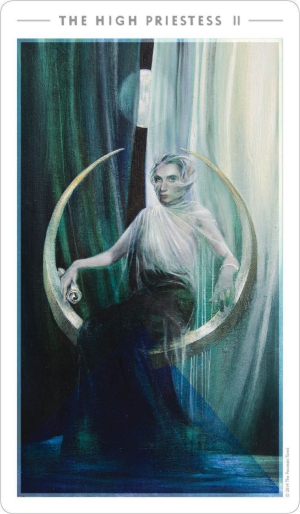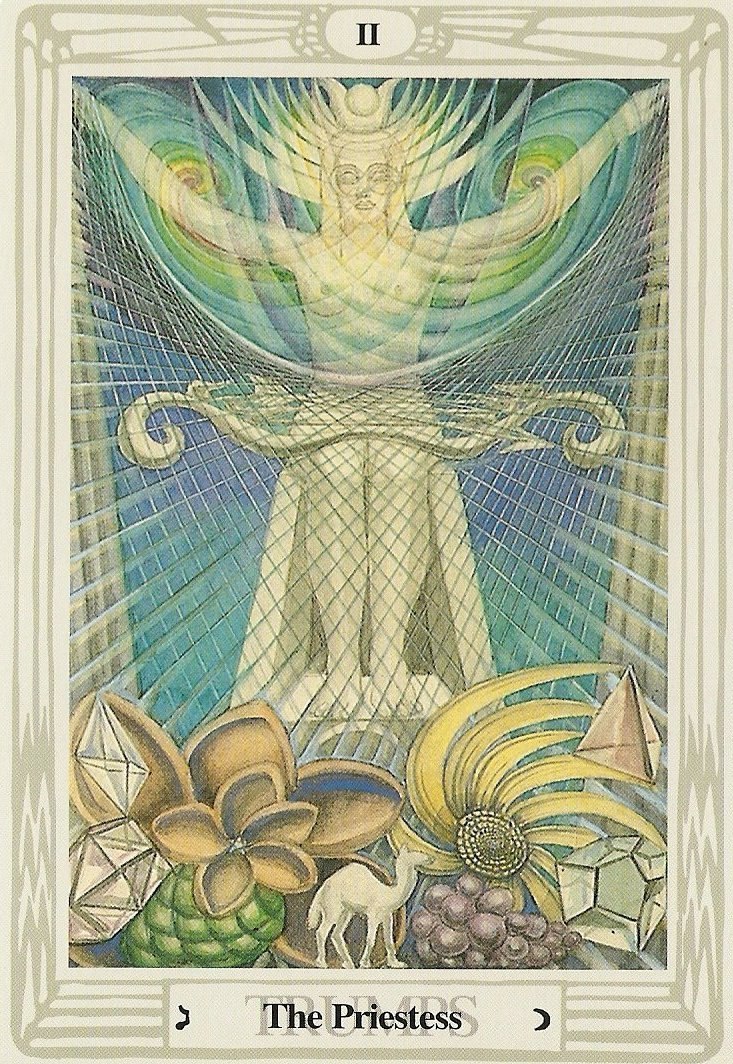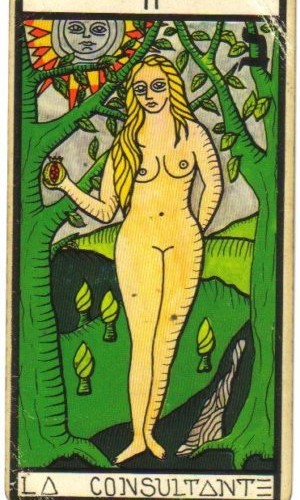The high priestess encourages me to persist in examining symbols and forming connections. She always seems to know something more, and I get to keep peeling back the layers. She inspires me to keep going deeper.
This particular onion never runs out of layers. I try to reconcile both the desire to expand my understanding, with also accepting there will always be mysteries and limitations. There’s both allure and frustration in mysteries that can never be fully resolved.
Who is the high priestess?
The High Priestess is the subconscious

The high priestess knows how to navigate her inner world and find wisdom there. It requires radical self-trust to follow your intuition and respect your own insights.
The high priestess is the sovereign of her own internal kingdom, and no one else gets the final say on who she is, or what she should think or feel. She has nurtured her own sense of what’s true or important.
When I say this is radical I’m very serious about it. There’s been such a turn against ideas that can’t be easily seen, touched or measured. We like to pretend we’re in complete conscious control of ourselves, and so we disconnect from our more mysterious or internal aspects.

We like to focus on extroversion, bustling activity and energetic leadership. Emotional or subconscious ideas might be pushed aside as weak or wishy-washy. But the high priestess is neither of these things. She’s a solid, determined figure, often staring straight ahead, happy to meet your gaze without flinching.
Some knowledge can’t be expressed consciously, but you can still feel it deep down. The high priestess is at peace with this kind of understanding. With the truths that resonate down deep into your bones.
- In what areas do you trust yourself?
- When do you doubt your instincts?
- What does it mean for something to be true? How is that different on a subconscious versus a conscious level?
The High Priestess is Receptive
Where the magician puts on a show and is concerned with what he’s projecting out into the world, the high priestess listens deeply, both to the world around her and her inner self. She knows how to use her senses to observe intently and take things in. She processes feelings and ideas on a deep level.
It would be a mistake to assume “receptive” is the same as “passive”. Mental states can be challenging to represent visually, and the image of a high priestess might seem to sit silent and impassive. But to perceive and understand is a highly active process. To wait or listen is also a calculated choice. Indeed, many people find this challenging, in a world with so much pressure to stay busy and active. That’s part of why the high priestess has such as important role for many of us. To rest, wait or turn inward isn’t a fail state interfering with your goal list, it’s part of the natural ebb and flow of activity we all benefit from.
It would be unwise to get stuck in either movement or stillness for too long, but there are times when that stillness is exactly what’s called for. Far better to rest or wait as a choice, embraced fully, rather than a crash after pushing yourself too hard. Periods of meditation or reflection leave us more alert and able to act. The high priestess can be at rest, but sometimes she’s deceptively ready to pounce!
The High Priestess Creates Firm Boundaries

The high priestess walks a line between staying open to her surroundings and putting up walls. She will often be shown draped in heavy robes or surrounded by veils, suggesting that she keeps her secrets well hidden. You are only going to see a fraction of the priestess’ wisdom. And yet, you aren’t left completely out in the cold. There’s probably a hint of something to work with, like a glimpse of water beyond the veil. She just isn’t going to let you through to see the full picture without some effort.
Sometimes the high priestess’ barriers are associated with frigidity, insecurities, or difficulty opening up. Though it could just as well relate to the importance of respecting personal boundaries. The high priestess knows how to say “yes” or “no”, wholeheartedly and enthusiastically. Both of these options are important, and the high priestess reminds us to listen to ourselves about when we need to be more open, and when we need to protect or limit ourselves.
Exercise: open or closed?
In tarot decks you have access to, does the high priestess feel more receptive, or more like she’s enforcing a boundary?
- What do you think it would take for a high priestess to open up?
- When would she keep you out?
- Which do you find more difficult: is it harder to open up, or to say no to things you don’t want to let in?
The High Priestess is a Teacher
It can feel like the high priestess is being mean by hiding knowledge instead of sharing it. But she can also act as a teacher or guide. She’ll point the way, but isn’t going to do the work for you. Maybe she has a key or a starting point, but then you’re going to have to step up from there. Look for an opening or direction.
Some things have to be experienced for yourself before they can truly be understood. No one else can hand you that full, embodied knowledge, even if they wanted to.
- What is something you are learning or would particularly like to learn?
- What kind of help or direction do you need?
- Are you more comfortable as a teacher or a student?
The High Priestess understands Dualities

The high priestess sits at number two in a sequence. Binary thinking can be restrictive, but at times when you’re stuck in a single point-of-view, seeing another side can be mind-blowing.
The high priestess shatters paradigms. She can create balance from opposite extremes, or find a new angle to approach an old problem.
In the Crowley-Harris Thoth deck, the high priestess Isis combines a solid foundation of straight lines in the bottom half of the card, with softer curved lines above. The shape of a receptive cup is formed from that combination, with both aspects being important to receive and understand knowledge.
The high priestess spans both the chthonic and the celestial. She is often linked to Persephone, the wife of Hades in Greek mythology. Persephone must spend part of the year on Earth with her mother Demeter, and part of the year in the underworld with her husband Hades, creating the seasons. Many high priestess cards feature pomegranates, the fruit Persephone ate in the underworld, meaning she could never return to Earth permanently.
The high priestess is often associated with the Moon, which is a celestial body, but also linked to the Earth and the body. She’s linked to the mystique sometimes attributed to inner physical processes such as menstruation. These inner workings of bodies have been considered both holy and unclean.
It’s difficult to avoid this weird simultaneous glorification and debasement of female bodies in how a figure like the high priestess is perceived. How we understand tarot archetypes has unavoidably been shaped by long-standing stereotypes and biases. In something like the World card, we can reach something beyond the limits of human concepts like gender (particularly binary gender). But tarot decks still explore gendered archetypes, sometimes in ways that are limiting. We have to make our own choices about how to work with these symbols from here.
The High Priestess is the Divine Feminine
Tarot imagery links the high priestess to a wide range of goddesses and religious figures, particularly those associated with wisdom or knowledge.
Traditionally, the high priestess might be a Christian “mother church” or “bride of Christ”. Many classic high priestess images featuring a book and veil are similar to classic art of the Virgin Mary during the Annunciation, when the angel Gabriel appeared to her.

The Priestess is Subversive
In these older tarot decks, such as the Marseille decks, the high priestess is instead called the popess. This seems like a weird thing to see. It might be a threat to our reality, where even in the present day a female pope would be radical. The high priestess can be rebellious, or have hidden strengths that aren’t accepted by a dominant power structure.
The popess is linked to multiple tales involving female popes. Although it’s almost certainly not true, one popular story involves the figure of Pope Joan. She was said to be a wise philosopher in 9th century Italy, who had to disguise herself as a man to be able to teach. When the pope died, she was elected to replace him, and her secret was only revealed several years later when she gave birth during a procession.

Another reference to a female pope is the Visconti Papess. In the late 13th century Italy, a group called the Gugleielmites believed their leader would be reborn to begin a new age in which women could be popes. They elected Sister Malfreda Visconti as their pope, though she was then burned for heresy. The Visconti Papess is likely to be represented in the Visconti-Sforza tarot, the oldest surviving tarot cards commissioned by the Visconti family in the 15th century.
Another female-pope story that could have influenced some tarot decks is Lucrezia Borgia, daughter of Pope Alexander VI. She created controversy by taking on some of her father’s duties while he was away.
- How do you fit into power structures?
- How do you subvert them?
- Do you think the high priestess would approve?
My approach to understanding tarot involves collecting ideas from many different decks, books and other sources, mixed with my own impressions. This necessarily remains incomplete and subjective. As always, take anything you can use and leave the rest.












